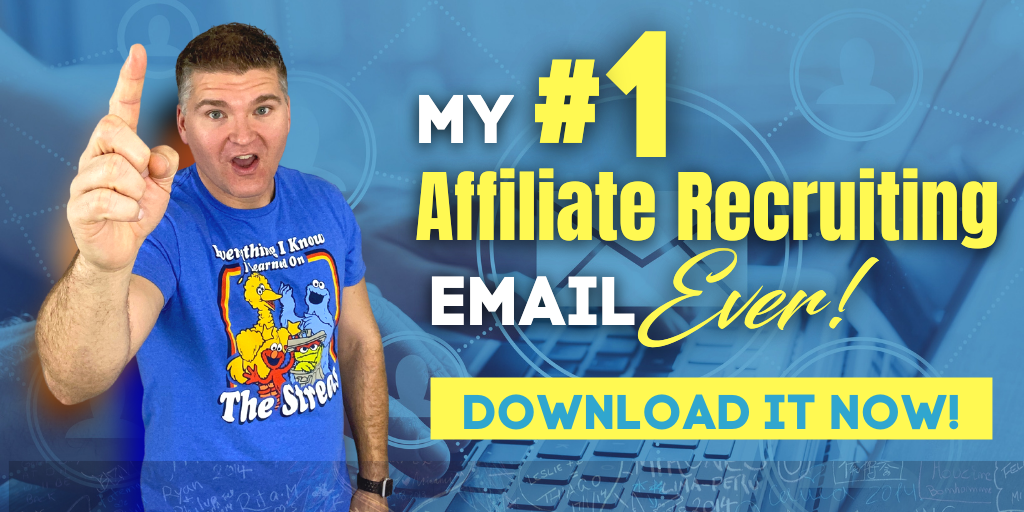There is a massive shift taking place in the affiliate marketing world. The old way of running affiliate programs is broken. For years, we’ve seen the signs of change, but now there’s a fundamental change happening in how the most successful programs are run. In today’s episode, I’m revealing the new model that’s shaping the future of affiliate marketing. Ignore these changes, and you risk being left behind.
Click Here for The Written Transcript of This Episode
Get the EXACT Template We Give to Our Affiliates to Get Them to Promote More and Generate More Sales! Click Here to Download it Now!
Links Mentioned in this Episode
10 Reasons Why You Should Work with Small Affiliates
TEXT ME: 260-217-4619
Don’t Miss An Episode – Subscribe Below
Previous Episodes of The Affiliate Guy
How to Activate Your Inactive Affiliates (And Make Them Lifelong Partners)
7 Secrets of 7-Figure Affiliate Launches
Should You Approve or Decline an Affiliate? How to Decide
How to Communicate Better with Your Affiliates
Successful Affiliate Onboarding: How to Setup Your Affiliates to Win
The MASSIVE Shift in Affiliate Programs is Here: Are You Ready?
Over the past couple of years, we’ve run multiple multimillion dollar affiliate launches, and they look nothing like the launches of ten years ago, five years ago, or even two years ago. Because of this seismic shift that’s occurring in the industry today, I’m sharing the new model for affiliate programs, and if you miss this, you will get left behind. Let’s get started.
So in the last episode I mentioned that the plan was to do a roughly five part series based on lessons from two huge affiliate launches that we ran recently back in March. Well, march through may actually total over $10 million in sales. And as I was preparing for this series, it ended up being like 8 9 10 11, parts. I’m not even entirely sure yet. And last week I talked about this kind of this new model, but I talked about it from the affiliate perspective.
This week I want to talk to you about it from the affiliate programs perspective. So as an affiliate manager or a product owner, what this means for affiliate programs? We have a bunch of lessons, like I said, at least eight parts coming up that are specifically from lessons from these launches. There’ll probably be a few episodes in the, like, the next few episodes are gonna be kind of a spin off from this one and then we will pick back up and like, so there’s really no exact pattern to these episodes, just to be clear. And if I didn’t tell you they were part of a series, you wouldn’t even know really. But today I wanna really hone in on this new model for affiliate programs like I’ve been predicting this shift would happen for years.
I always joke it’s slide 37 on my webinar because it’s slide 37 on my webinar where I talk about this is the way affiliate programs should be run and this is how we run them. You know, I started it about six, seven years ago and now finally people are getting on board that is changing the entire landscape of affiliate programs and affiliate marketing.
The traditional model is just getting thrown out the window. And this new model, as I said last week, it’s the model of the future. And the future is now. So what is this shift I’m talking about? What’s the shift? From the belief that in order to run a successful, and for some of you, this means multimillion dollar affiliate program, to run a successful affiliate launch, to run a successful evergreen program. You have to have a bunch of big names and big affiliates or really, you need a handful, not a bunch, you need a handful of big names. Like, I just got to go out and get like four or five big names, big affiliates. This is simply not true.
The shift is that affiliate programs are moving away from this model of only working with big established affiliates and moving toward building an army of small, engaged affiliates. The shift is going away from, well, we have like three or four big name people that maybe have no sense of loyalty to us to, we’re going to work with 1000 potentially, you know, both of these big launches I talked about had one, had about 501, had over They were mostly small and they were super engaged, super loyal, super dedicated to the promotion.
Like, they were going. Some of them who had tiny, tiny lists, and I’m talking like under 200 people were working their butts off just to make three or four sales. And I’ve had, I mentioned this in the last episode, like, I have had multiple private conversations with some of these high level entrepreneurs people.
Some of these are clients. Some of these are just people that are, you know, they’ve run 5 and $10 million launches. They’re on board with this trend. I’m not going to mention names, but one in particular, he’s, I’m done with the whole, like, reciprocal promotion thing. I’m done with the whole, you know, we got a, like, I promote you, you promote me, I’m done with the whole, like, you know, people backing out because of, you know, like, their calendars got in the way.
Need help activating your affiliates? Use my proven email templates for getting inactive affiliates in the game and making sales! Get them here!
He’s like, I only want to work with people who are loyal. I want to work with people who are completely and utterly dedicated to my promotion. I want to work with people who are, that have an experience with my product, with my course, whatever it may be. And they’re saying, you know what? Like, I had a good experience with this. It changed my life and I have to be an evangelist for it. I only want to work with evangelists, not just people who are in it for the money, not just people who send a few emails. And yeah, maybe they send only a couple of emails and they make five sales each, and that equals more.
And that’s that new model. That’s that new model. I just did a Facebook live. Let’s see when this will air. So I probably did this Facebook live about two, two and a half weeks ago. Based on when this actually airs as an episode about two and a half weeks ago, and it was called ten reasons why you should work with small affiliates.
And I’ll link to that in the show notes, so I won’t repeat what I said in that, but just to give you kind of a high level overview, I talked about some of the benefits of working with these small affiliates because a lot of people say, well, it’s not worth working with small affiliates. They’re not going to make many sales. Well, remember the whole thing about not putting all of your eggs in one basket?
If you only have five or six affiliates, that’s five or six baskets versus 1000 baskets. And so one of the reasons that I love small affiliates is that diversification, you know, with that diversification of your affiliate base and building that army, I talked about, you know, how smaller lists are more engaged, how smaller affiliates are generally more open minded.
They’re going to actually follow what you teach them. They attend your trainings. They learn, they tend to be more loyal. They’ll promote you more often. You know, you’re loyal affiliates. You might have, you know, hundreds of smaller affiliates, and they’ll promote you two or three times a year if you let them. And then they grow, you know, small affiliates grow and they help you create this affiliate army. And I shared this example in there, and I’ve shared this before on the podcast, but I talked about how, you know, imagine if you have 100 small affiliates, if you have 100 small affiliates today, and these are affiliates that maybe that make an average of a half a sale.
So 50 sales between these 100 affiliates, you could have, say, three affiliates who make 500 sales. So 50 versus 500, 500 versus 50 with a fraction of the effort. But here’s what happens. If you fast forward the next year, those 100 affiliates that made 50 sales last year, they’ll make 150 this year. Okay, still not 500.
But one of those three doesn’t promote. So now you’re down to 300. So you’re at half, you’re at half the, you know, the amount. The next year, those 100 affiliates, they make 300 sales equal to what your big affiliates made the following year they make 700. The following year. After that they make 1500. And that’s what happens.
Because of those hundred, what will happen is 50 of them. If you fast forward five years, even three or four years, if you fast forward a few years, 50 of them will basically double in size. So they’ll go from maybe a list of 300 to a list of 600. Not a substantial growth, but they’ll go from making an average of a half a sale to one sale. Okay. That’s an additional 25 sales out of those hundred. That’s not bad something, you know, it’s noticeable. $2,000 product, that’s 50 grand. That’s. I don’t care how big you are.
An extra $50,000 is nothing to sneeze at. So we’ll go from a half a sale on average, to maybe two sales on average. Okay. You sit on a micro level, like, whoop, do you fricking do, right? But that’s an extra roughly $125,000, give or take a little bit of math there. That’s noticeable. So that’s 80 that have either doubled to four x’ed, you know, again, not huge on a micro level, but starts adding up another ten will five to seven x. So they go from a list of 200 to 1000 but that means they go from a half a sale to four sales or three sales. Okay, pretty cool. So you have ten left. Two or three of those ten will ten or twelve x.
All right, now we’re starting to talk. But still nothing major. But guess what? Three or four, five of those 100 will 50 to 500 x they’ll get on Oprah, they’ll get featured in a major magazine they’ll figure some marketing out on their own and their list will go from 300 people to And they will remain loyal to you forever. And they will continue to promote you and promote you and promote you and promote you. And they’ll go from making a half a sale to 400 sales more than any one of those original top three because of that loyalty. And I had been preaching this for a decade that this is the way to do it. And now it’s starting to come to light.
Now everybody’s starting to see this, you know, and we had talked about those two launches, right? One of those launches, they lost almost half their top ten. The other launch lost eight of their top ten including, let me do the quick math, 27 28% of their sales from one affiliate. Like massive affiliates. But we fostered those small relationships. In one of the launches, the total affiliate sales, 2042 total affiliate sales of a $2,000 product. You wouldn’t recognize more than one or two names in the top 40.
If you look at that leaderboard last year you’d recognize a lot of names including me. I finished like 8th place in that launch last year. You would recognize a lot of the names. You wouldn’t recognize almost any of the names in the top 40. This year we had 215 affiliates with a sale. You can do the math. What’s 2042 divided by 215?
Less than ten. Average affiliate had less than ten sales. Get this, of the 215 with a sale, almost exactly half almost exactly half of those affiliates, it was their first ever sale of that product. Get this. Total sales from first time affiliates, 40%, 40% of all the sales not just their first sale of that product. It wasn’t just their first affiliate promotion of that product.
It was their first affiliate promotion ever. Oh, those people aren’t worth working with. Those people aren’t worth working with. Well, because they take too much effort. They require too much handholding. I mean, they don’t even move the needle. They email you 42 times and then make one sale. It’s not worth it.
First of all, they don’t require that much effort. You can do these things in a group. You can train them in a group. We’ll talk about that in the next few episodes. But they help you create that army of loyal affiliates who promote often and will grow. And like I said, they’re more open minded and they learn and they follow what you tell them to do.
You know, I think of in one of the launches, you know, one of the affiliates the previous year, Sarah Williams, had nine sales. Nine. Not exactly a tiny affiliate. You know, $18,000 in sales is not something to sneeze at, but not, you know, compared to a $2 million affiliate, not exactly a huge deal this year. More than 170 sales. More than 170 sales. Why? Because of the training and the listening and the following, what we teach.
But what if we hadn’t have invested in her? What if she just made nine again? Or maybe what if she made 15? Well, we’d have missed out on 300 something thousand dollars in sales. And if you actually look at the numbers, everyone improved. Like, everyone who finished in the top ten this year, almost on the small end.
Let me think of them. Grew by 80% or more this year. These were all, like, affiliates who finished in 28th place last year, down to, like, the top 30, and we’re talking affiliates with, you know, $40,000 plus sale, some of the affiliates that made $40,000 or more weren’t even on our radar as far as being top affiliates, but they attended the training sessions, they paid attention, they executed, they went out of their way, they did everything we said to do and more, and they ended up being a top 30 affiliate.
We noticed the same thing in both of these launches. The exact same thing. Exact same thing happened in both of these launches. But it’s been like this for years. This is not like a new thing. It’s just that it’s coming to light because it’s happening more frequently and it’s happening at a higher level. When we were proving this model years and years ago, and we proved it with Michael Hyatt’s launches years ago, it was like a $1.2 million launch, which was four times bigger than his previous launch. But it wasn’t a $5.5 million launch.
Get my #1 affiliate recruiting email (the one I’ve personally used to recruit thousands of affiliates in dozens of niches). Grab your copy here!
We did, like I said, a launch with Michael Hyde. And we had. If you look at the top of our leaderboard, it was Jeff Walker, Sally Hogshead, Pat Flynn, Ray Edwards, Stu McLaren, John Lee Dumas, Jeff goins. Like, it’s a who’s who, right? But the top three, top three affiliates, Jeff Walker, Sally
Hogshead and Ray Edwards, only accounted for 14% of sales. Of the top ten only accounted for 27% of sales. We had five. I think we had 514 affiliates make at least one sale. Most of our sales came. If you look at the total number of sales, it was from affiliates who had five or less sales. The affiliates who had five or less sales, I believe, accounted for just over 50% of the total sales. If you went up to, like 20 or less, like, 20 or less was like 64% of all sales. No, no, back up 40% was five or less. That’s what it was. It was 40, it was 41% had five or less. It was like 63 or 64% had ten or less sales. It was crazy.
Ray Edwards. This is all the way back in, like 2015,16. Jeff Walker, Jeff Bullis, Don Miller, Michael Hyatt, Dan Miller, Craig Ballantyne, Chandler Bolt, John Nemo at the top of the leaderboard. Right? And yet their top three, Jeff Walker, Jeff Bullis and Donald Miller, only accounted for 19% of sales.
Their top ten barely accounted for a third of their sales, 34%. We had 16 affiliates that year who ended up finishing in the top 20. That doubled their sales year over year. And then the following year, we had a guy named Mike Kim, who wasn’t even a. Was like sniffing the leaderboard. The year before he won the affiliate competition, he beat Jeff Walker with a list of 5000 people. Why? Because we invested in him. And I remember we met at the mastermind. We had a mastermind for the top affiliates. We met in coeur d’Alene, Idaho. We brought all the top affiliates in for like a two or three day mastermind. We went hiking, we went out to dinner.
We had some fun together. And I was like, dude, everybody wants to know, man, how’d you do it? How did you win this thing? He’s like, I just did what you said to do, man. And just whatever you said to do, I did it. Okay? What am I. Is that me bragging there? Yes, a little bit. But no, what I’m saying is he’s a small affiliate. He doesn’t know what he doesn’t know.
He followed what I taught and it worked and he actually won. And the end result was Ray had two times his annual revenue in just one month. Two times his entire previous years, like revenue he got in one month. The same story is playing out time and time again. It’s why people are coming to us to ask for help. It’s like, it’s why our coaching program, you can find out more about. It’s called your affiliate launch coach. Just go to youraffiliatelaunchcoach. com and you can apply there.
When you apply, by the way, we’ll just have a call. We’ll see if you’re a good fit, let you know what the investment will be and what that looks like. So there’s no obligation, just to be clear. That’s why, like people are blowing that up, because the old model simply does not work. The old model simply does not work. The old model says, you know, again, you have to, like, most of your sales are going to come from only a few affiliates. Like this lie is so pervasive that I literally heard one of the top names like this is someone you know.
One of the top names in Internet marketing space claimed this as a statement, a fact from stage. I wrote it down in my book that I was taking notes and he said, 90% of your sales will come from your top three to five affiliates. Let me be brutally clear here. This is nothing more than a cop out. This is an excuse not to work with smaller affiliates, not to invest in the resources of time and energy and occasionally a little bit of money. What it takes to get those smaller affiliates to perform.
It’s an excuse not to work with them. You’re going to miss out on all those advantages, though, right? But it’s an excuse to go out, get your three or four best buddies if one of the big Internet marketers, maybe a few other people, call it a day. But I go back to something that I’ve repeated often, like, if you’re listening to this podcast, I don’t think you’re one of those people who’s just content to sit back and run your little insiders club with a few affiliates. And that’s it. Am I right? Like, if you believe, you know what Tony Robbins says, if you’re not growing, you’re dying. Standing still. I don’t even care. I don’t care if that still is a $20 million company.
It kind of just doesn’t feel right. It doesn’t feel right. It feels like I’m standing still because I am. It feels like I’m dying. And so this client or this person that I mentioned from stage that said that this person that got up there in front of everyone and said, 90% of your sales will come from your top three to five affiliates, they’re a client now. They’re a client now. They’re on board with this new model. Now. This new model says that you don’t have to have a personal relationship with all of your affiliates. You don’t need to be best buddies with all of your affiliates. If you’re going to run an affiliate program that is consistently growing year after year. It’s simply not possible.
Like we said earlier, you want an army of affiliates, some of whom you might not even know. You might not even know. This new model says that small affiliates are worth the quote, unquote hassle. They’re worth the hassle because of all the things I said before, because of the diversification. Because they’re small lists, they might only have 500 people on their list versus somebody who’s got 50,000. Those 500 are super engaged. And when you have a small list versus a big list, like know you can be a Mike Kim beating Jeff Walker.
It’s worth it because they’re more open minded and they learn and they will follow what you tell them and they’re more loyal and they’ll promote you more often, and they grow and they help you create that army. It’s worth it. It takes some time. It doesn’t necessarily pay off right away, but it’s worth it in the long run and it’s even worth it in the fairly short term. A year or two or right. Right away. You could be missing out on 40% of your sales.
If you are ready to take your business to the next level and start an affiliate program, start with my free report, Your First 100 Affiliates. This report takes nearly two decades of experience, trial and error, and lessons learned about finding top affiliates in nearly every conceivable niche and puts them all into one report. Grab your copy here!
And the other launch that I mentioned, it was almost 25%, wasn’t quite as dramatic. You know, almost half the sales. But one quarter of all the sales were from first time affiliates. Even higher. Almost a third of the sales were from people who made their first affiliate commission. They’d done one or two affiliate promotions before and never made a dime.
So you say, well, they’re not worth it. They’ve done, they’ve, they’ve promoted two affiliate promotions and not made a dime. No, this was their first. In the one, the first one where 40% were from first time affiliates, it was almost 50% were from people who made their first affiliate commission.
One lady that I’m thinking of in particular, who doesn’t count in that 40%, she had eleven sales, $22,000, not in a scheme of a $5. 5 million launch, not a dramatically huge deal. But I look at it this way, it pays about a quarter of a team member’s salary for the year. Probably. That’s pretty cool. Three months salary. This lady. It was the third time she’d ever promoted something as an affiliate. She promoted the same thing last year and she promoted something else earlier in the year and made zero sales in both. Well, what was the difference? And again, yes, I’m bragging in a way.
The difference was I invested in her, I trained her. She showed up to every training. She went through, every work. She, she followed the model. She did exactly what we told her to do. She made eleven sales. She made $5,000 in commissions. No, $8,000 or 9000, whatever 40% of 22,000 is. She made that $8,800 in commissions. She brought in $22,000 for us. When I say I invested time with her, I individually responded to a few emails and a Facebook message and a DM on Facebook. Everything else was in a group. I would have spent that time whether she had been there or not.
So the total amount of time I spent specifically with her was probably five to eight minutes. But every transaction I made her feel like she was somebody worthwhile because she is. And it paid off. Doesn’t necessarily pay off right away like that, but it will pay off. So the old model is broken. This old model just bringing on a few affiliates and letting them go, it does not work. So if the old model does not work, what does? What does work? Well, stay tuned, because over the next few episodes. I’m going to share exactly what to do.
I’m going to share what we call the three c’s of successful affiliate programs. These three c’s are how you get these small affiliates to outperform. These three C’s are how you get a first time affiliate to make 10, 20,30, These three c’s are how you even get the bigger affiliates who might make 100 sales to make 120 and 125. It works on all levels of affiliates.
These three C’s are the key to successful affiliate programs and they’ve been what we’ve based our success on with our clients over the years. So again, just as a reminder, I will link to that Facebook live that I did the ten reasons why you should work with smaller affiliates. You definitely want to go check that out. I’m also going to link in the show notes.
If you want to start getting if you want to get started, you want to go find affiliates. Whether you know them or not, you have a relationship with them and they’re small or big. If you go to Matt mcquahliams. com first 100, I’ll show you how to find affiliates. So make sure you go grab that free report if you haven’t already and also link to our coaching program so you can apply for that and we’ll talk and see if it’s a good fit see if you’re a good fit for your affiliate launch coach so all those will be linked in the show notes. Make sure you check those out and I’ll see you in the next episode.
For part one of the three C’s of successful affiliate programs, make sure if you haven’t yet, make sure you subscribe in your favorite podcast player, whatever it is. Subscribe so that you don’t miss an episode. And if you know someone who could benefit from this episode, they bought into the old model and they need to know this new model and then they need to know the three C’s and everything else in a I’m going to be sharing over the next few weeks.
Make sure you share this episode with them so they get the benefit from this information as well. With that wrap up and like I said, I will see you in the next episode. Part one the three C’s of successful affiliate programs thank you so much for listening today.
See you soon.
Make sure that your affiliate program has a solid agreement (AKA Terms & Conditions). To make things simple, grab my template here!





